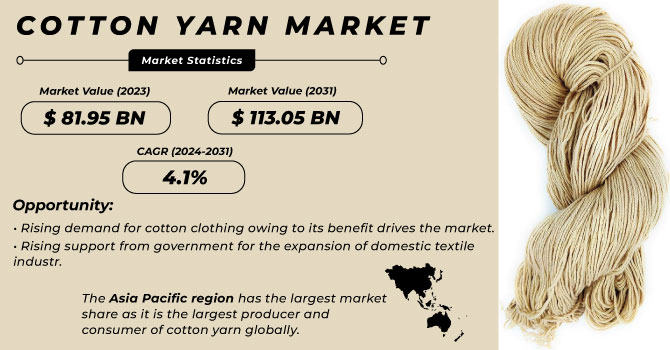
The SNS Insider report estimates the Cotton Yarn Market size at USD 81.95 billion in 2023, with a projected CAGR of 4.1% to reach USD 113.05 billion by 2031.
The global cotton yarn market is being primarily driven by the increasing demand for natural fibers, fueled by rising consumer preferences. The expansion of end-use industries, such as garments and home textiles, is also contributing to the market’s growth across various regions. For example, India, a major cotton producer, reported a 7% increase in exports of cotton yarn, fabric, and handloom products, reaching $11.7 billion in FY24.
Cotton, known for being lightweight and breathable, is ideal for summer clothing and accessories, offering comfort and a pleasant feel against the skin. These advantages are expected to support the growth of the cotton yarn market. The market is further propelled by its growing use in downstream industries and heightened consumer awareness of the quality and suitability of pure cotton yarn. A notable trend in the cotton yarn market is the adoption of technological advancements. Leading companies are continuously developing new technologies to maintain their market position.
Get a Report Sample of Cotton Yarn Market @ https://www.snsinsider.com/sample-request/3409
Some of the Key Players Included are:
- Huafu
- Huamao
- Texhong
- Weiqiao Textile
- Lutai Textile
- Henan Xinye Textile
- BROS
- China Resources
- Nishant Mills
- Aarti International
- and other
Segment Analysis
The cotton yarn market is segmented into combed yarn and carded yarn. The carded yarn segment is expected to dominate the market during the projection period due to its cost-effectiveness and rapid production capabilities.
Carded yarns are generally more cost-effective than combed yarns. The carding process, which involves separating and aligning the cotton fibers, is less intensive and faster than the combing process. This increased efficiency is crucial for meeting the high demand for cotton yarn, especially when large volumes are needed in a short timeframe.
By Type
- Carded Yarn
- Combed Yarn
By Application
- Apparel
- Industrial Textiles
- Home Textiles
- Other
Competitive Insights
Leading companies are increasingly integrating automation and robotics into the cotton yarn production process to manage tasks such as material handling, loading and unloading bobbins, and conducting quality control inspections. They are also implementing advanced online monitoring and control systems to ensure consistent yarn quality and to identify production issues in real time. These systems help monitor parameters like yarn tension, twist, hairiness, and evenness, enabling necessary adjustments to optimize the spinning process.
Additionally, the growing use of computer-aided design (CAD) systems in the design and development of cotton yarns is bolstering market growth. CAD systems allow for the simulation of different yarn structures, prediction of performance, and optimization of yarn properties based on specific requirements. This technology reduces trial and error processes and enhances the efficiency of yarn development.
Make Enquiry About Cotton Yarn Market Report@https://www.snsinsider.com/enquiry/3409
Recent Developments
July 2023: Better Cotton partnered with the Cotton Egypt Association to enhance the Better Cotton program in Egypt, promoting sustainable practices and protecting Egyptian cotton globally.
September 2023: Authentic Brands Group and Taram Textiles launched the Reebok Home Collection in the US and Canada, featuring bedding and bath items inspired by Reebok’s performance ethos.
August 2022: Coats Group plc acquired Rhenoflex GmbH, a leading global manufacturer of sustainable reinforcement solutions for the footwear and accessories industries.
Impact of Russia-Ukraine War on Cotton Yarn Market
The Russia-Ukraine conflict has cast a shadow over the cotton yarn market, triggering disruptions across the global supply chain. As Ukraine plays a significant role as a cotton producer and key player in international trade, the conflict has injected uncertainties into supply routes, logistics, and trade agreements. This upheaval has sparked concerns about potential shortages and price fluctuations within the cotton yarn market. Furthermore, geopolitical tensions and economic sanctions have compounded these challenges, disrupting trade flows and exacerbating market volatility. Industry stakeholders are vigilantly monitoring the situation, implementing strategies to navigate risks, and ensure the uninterrupted flow of supply and operations amid this uncertain landscape.
Regional Analysis
In 2023, Asia Pacific emerged as the dominant force in the cotton yarn market, boasting the highest revenue share. This trend is projected to persist over the forecast period, fueled by rising demand from its burgeoning population. The region’s textile industry is experiencing rapid expansion, driven largely by key nations including China, India, Japan, and Southeast Asia. China, in particular, stands out with its extensive production capabilities and a plethora of leading companies driving growth in the apparel sector. The surge in urbanization and escalating consumer spending on clothing are anticipated to further bolster the demand for cotton-derived yarn in the coming years.
Key Takeaways:
- The global cotton yarn market is set for substantial expansion, driven by the rising utilization of cotton yarn in both apparel and home textiles.
- Strategic alliances, cooperative ventures, investments, product introductions, and advancements among companies play a pivotal role in securing essential components, expertise, and market positioning.
- The apparel segment is expected to dominate the cotton yarn market in the forecast period.
- The Asia Pacific region is poised to uphold its dominance, propelled by the rapid expansion of the textile industry. This growth is predominantly fueled by key nations including India, China, Japan, and Southeast Asia.

Table of Contents – Major Key Points
- Introduction
- Research Methodology
- Market Dynamics
- Impact Analysis
- COVID-19 Impact Analysis
- Impact of Ukraine- Russia war
- Impact of ongoing Recession
- Value Chain Analysis
- Porter’s 5 Forces Model
- PEST Analysis
- Cotton Yarn Market Segmentation, By Type
- Cotton Yarn Market Segmentation, By Application
- Regional Analysis
- Company Profiles
- Competitive Landscape
- Use Case and Best Practices
- Conclusion
Buy the Latest Version of Cotton Yarn Market Report 2024-2031 @ https://www.snsinsider.com/checkout/3409
About Us:
SNS Insider is one of the leading market research and consulting agencies that dominates the market research industry globally. Our company’s aim is to give clients the knowledge they require in order to function in changing circumstances. In order to give you current, accurate market data, consumer insights, and opinions so that you can make decisions with confidence, we employ a variety of techniques, including surveys, video talks, and focus groups around the world.
Contact Us:
Akash Anand – Head of Business Development & Strategy
info@snsinsider.com
Phone: +1-415-230-0044 (US) | +91-7798602273 (IND)



